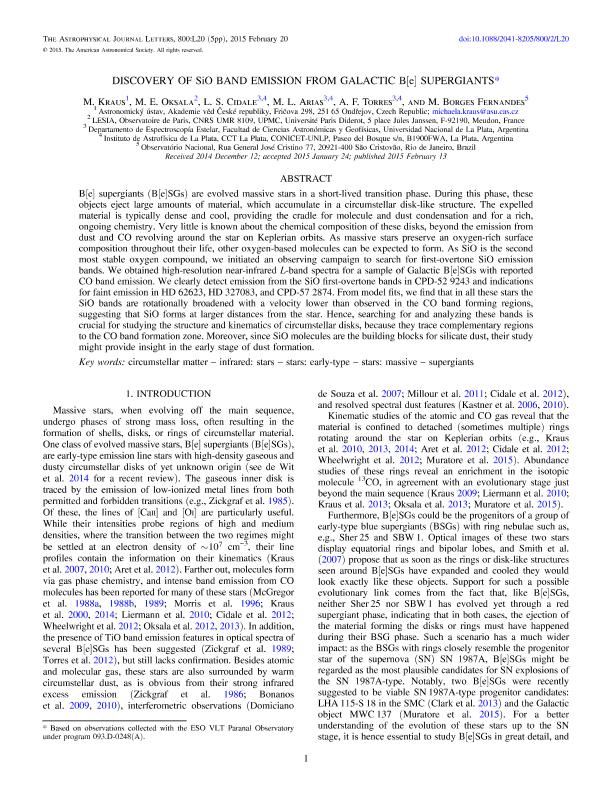Artículo
Discovery of SiO Band Emission from Galactic B[e] Supergiants
Kraus, M.; Oksala, M. E.; Cidale, Lydia Sonia ; Arias, María Laura
; Arias, María Laura ; Torres, A. F.; Borges Fernandes, M.
; Torres, A. F.; Borges Fernandes, M.
 ; Arias, María Laura
; Arias, María Laura ; Torres, A. F.; Borges Fernandes, M.
; Torres, A. F.; Borges Fernandes, M.
Fecha de publicación:
02/2015
Editorial:
IOP Publishing
Revista:
Astrophysical Journal
ISSN:
2041-8205
Idioma:
Inglés
Tipo de recurso:
Artículo publicado
Clasificación temática:
Resumen
B[e] supergiants (B[e]SGs) are evolved massive stars in a short-lived transition phase. During this phase, these objects eject large amounts of material, which accumulate in a circumstellar disk-like structure. The expelled material is typically dense and cool, providing the cradle for molecule and dust condensation and for a rich, ongoing chemistry. Very little is known about the chemical composition of these disks, beyond the emission from dust and CO revolving around the star on Keplerian orbits. As massive stars preserve an oxygen-rich surface composition throughout their life, other oxygen-based molecules can be expected to form. As SiO is the second most stable oxygen compound, we initiated an observing campaign to search for first-overtone SiO emission bands. We obtained high-resolution near-infrared L-band spectra for a sample of Galactic B[e]SGs with reported CO band emission. We clearly detect emission from the SiO first-overtone bands in CPD-52 9243 and indications for faint emission in HD 62623, HD 327083, and CPD-57 2874. From model fits, we find that in all these stars the SiO bands are rotationally broadened with a velocity lower than observed in the CO band forming regions, suggesting that SiO forms at larger distances from the star. Hence, searching for and analyzing these bands is crucial for studying the structure and kinematics of circumstellar disks, because they trace complementary regions to the CO band formation zone. Moreover, since SiO molecules are the building blocks for silicate dust, their study might provide insight in the early stage of dust formation.
Archivos asociados
Licencia
Identificadores
Colecciones
Articulos(IALP)
Articulos de INST.DE ASTROFISICA LA PLATA
Articulos de INST.DE ASTROFISICA LA PLATA
Citación
Kraus, M.; Oksala, M. E.; Cidale, Lydia Sonia; Arias, María Laura; Torres, A. F.; et al.; Discovery of SiO Band Emission from Galactic B[e] Supergiants; IOP Publishing; Astrophysical Journal; 800; 2; 2-2015; L20-L24
Compartir
Altmétricas



